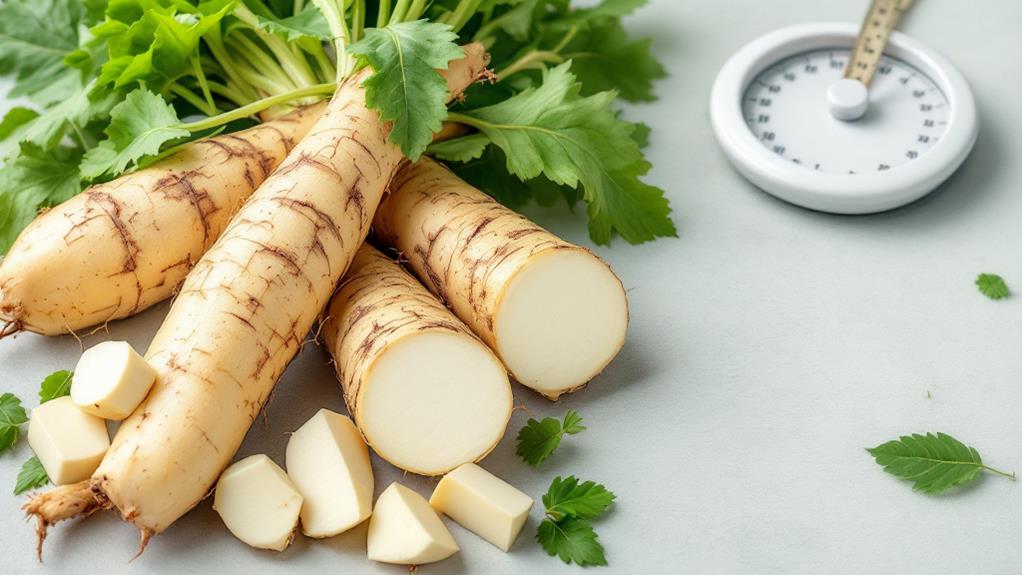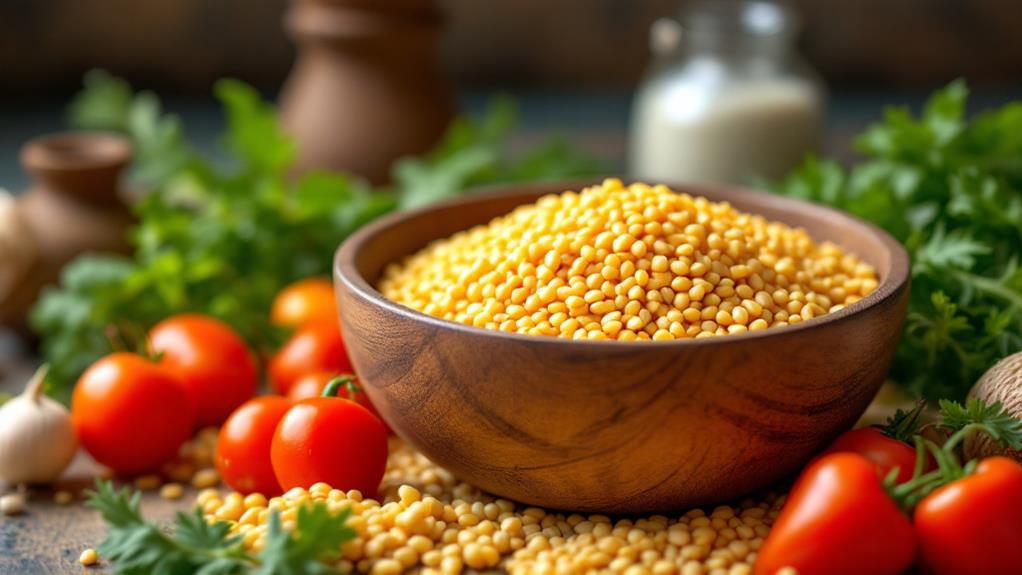What Are the Health Benefits of Taro? A Root Vegetable Worth Trying

Taro is a nutrient-packed root vegetable that elevates health in numerous ways. It's rich in fiber, supporting digestive health and maintaining bowel regularity. You'll find its resistant starch helps stabilize blood sugar, making it beneficial for managing diabetes. Taro's antioxidants, like quercetin, reduce oxidative stress and inflammation. With potassium to balance blood pressure and fiber to lower cholesterol, your heart health gets a significant lift. Plus, its low-calorie content makes it a great option for weight management. Whether boiled, baked, or fried, taro enriches your meals with added nutritional value. Investigate more to uncover taro's full benefits.
Nutritional Overview
Taro root often stands out as a powerhouse of nutrition, providing a substantial energy boost thanks to its high carbohydrate content. With 187 calories per cup, it's an excellent source of energy to fuel your day. Beyond its calorie content, taro root is packed with vital nutrients, making it a valuable inclusion in your diet. You'll find it rich in manganese, vitamin B6, potassium, and copper, helping to support numerous bodily functions.
One of the remarkable features of taro is its fiber content. Each serving offers 6.7 grams of dietary fiber, which plays a significant role in promoting overall well-being. This fiber, along with the resistant starch found in taro, can help you manage your weight by increasing feelings of fullness, ultimately curbing unnecessary snacking. Resistant starch also contributes to maintaining steady blood sugar levels, offering more health benefits.
Taro root is low in fat and filled with antioxidants like quercetin, which can help combat oxidative stress and reduce the risk of chronic diseases. By incorporating taro into your meals, you're not only enjoying a tasty dish but also reaping the rewards of its nutrient-rich profile.
Digestive Health Benefits
Packed with fiber, taro root considerably improves digestive health by promoting bowel regularity and preventing constipation. With 6.7 grams of dietary fiber per cup, it's a fantastic supplement to your diet for maintaining a healthy digestive system. Fiber isn't just about keeping things moving; it also plays a significant role in alleviating symptoms of irritable bowel syndrome (IBS) and preventing digestive disorders.
Taro root contains resistant starch, about 12% of its starch content when cooked, which supports your intestinal health by slowing digestion. This process helps steady the release of energy and prevents the rapid conversion of starch into glucose, aiding in digestive health management. Beyond that, fermentation of the fiber in taro encourages the growth of beneficial gut bacteria, which is vital for a balanced microbiome.
Here are three ways taro root improves digestive health:
- Promotes bowel regularity: The high fiber content helps prevent constipation and guarantees smooth digestion.
- Supports gut bacteria: Fermented fiber fosters beneficial bacteria, improving intestinal health.
- Alleviates digestive disorders: Regular fiber intake can reduce symptoms of digestive disorders like IBS.
Incorporating taro into your meals can be a tasty way to elevate your digestive health!
Blood Sugar Control

When you're looking to manage your blood sugar levels, taro root can be a valuable ally. This root vegetable is packed with fiber and resistant starch, both of which play an essential role in stabilizing blood sugar levels. The resistant starch in taro, which makes up about 12% of its starch content, doesn't impact your blood sugar. It helps slow digestion, reducing those pesky post-meal blood sugar spikes that can be troublesome, especially for individuals with type 2 diabetes.
Taro root's low glycemic index makes it an excellent carbohydrate choice for maintaining steady blood sugar levels. It prevents rapid fluctuations, offering a more controlled release of glucose into your bloodstream. This can be particularly beneficial if you're trying to improve your insulin sensitivity. In fact, diets high in fiber, like those including taro, have been known to lower blood sugar levels by about 10 mg/dl in people with type 2 diabetes.
Incorporating taro regularly into your meals can also boost your general digestive function, further supporting effective blood sugar regulation. Its unique combination of fiber and resistant starch makes it a smart supplement to your diet.
Heart Health Support
In conjunction with its benefits for blood sugar control, taro root supports heart health in several significant ways. Initially, it's rich in dietary fiber, boasting 6.7 grams per cup. This fiber helps lower cholesterol levels, which can reduce the risk of coronary heart disease. Secondly, taro's high potassium content (18% of your daily value per cup) plays an essential role in maintaining healthy blood pressure, a key factor in cardiovascular health. Finally, the antioxidants found in taro, such as quercetin, help combat oxidative stress and inflammation, both linked to heart disease development.
Regularly incorporating fiber-rich foods like taro into your diet can lead to impressive heart health benefits. Consider this:
- Lower Cholesterol: Taro's fiber content aids in reducing cholesterol levels, benefiting your heart.
- Blood Pressure Regulation: Its potassium content supports blood pressure control, vital for cardiovascular health.
- Reduced Risk of Heart Disease: Antioxidants in taro help diminish oxidative stress, lowering heart disease risk.
Moreover, taro's low glycemic index helps stabilize blood sugar levels, decreasing the chance of cardiovascular complications associated with diabetes. Consuming taro root can be a tasty and effective way to support your heart health.
Weight Management

Beyond heart health, taro root offers significant benefits for weight management. It's packed with fiber, containing 6.7 grams per cup, which helps you feel full longer and naturally reduces your total calorie intake. This makes it easier to manage your body weight effectively. When you include taro in your diet, you're opting for a food that's low in calories, providing a satisfying alternative to higher-calorie starches, thereby supporting your weight loss goals.
The resistant starch in taro root further improves these benefits by promoting fullness even after you've finished your meal. Studies have shown that resistant starch can lead to a 6% reduction in calorie intake, a significant factor in maintaining or reducing body weight. High-fiber diets, including those that feature taro, are linked to lower body weight and reduced body fat percentages, making them an excellent choice for anyone focused on weight management.
Moreover, each extra 10 grams of fiber you consume daily can decrease your risk of heart disease mortality by 17%, highlighting taro's dual health benefits. By incorporating taro root into your meals, you're not just managing weight but also improving total well-being.
Antioxidant Properties
Taro root stands out as a powerhouse of antioxidants, particularly rich in polyphenols like quercetin. These antioxidants play a vital role in reducing oxidative stress, which is fundamental for lowering the risk of chronic diseases. By combating free radicals, taro root helps protect your cells from damage and inflammation. This protection contributes to improved immune function, making your body more resilient against illnesses. Including taro root in your diet can lead to numerous health benefits, such as improved longevity and overall wellness.
Here's how taro root's antioxidants work their magic:
- Reduce Oxidative Stress: The polyphenols in taro root neutralize free radicals, lessening the impact of oxidative stress on your cells.
- Cancer Prevention: Studies suggest that these polyphenols may inhibit the growth of certain cancer cells, showcasing taro root's potential role in cancer prevention.
- Boost Immune Function: Regularly consuming taro root strengthens your immune system, thanks to its ability to combat free radical damage.
Incorporating taro root into a balanced diet guarantees you reap these health benefits, promoting better health outcomes. Its antioxidant properties make it a valuable addition to your meals, offering protection and nourishment.
Culinary Uses and Preparation

While taro root's antioxidant properties offer remarkable health benefits, its culinary versatility makes it an exciting ingredient to work with. Regardless of whether you're a fan of savory dishes or sweet recipes, taro root can be prepared in countless ways, including boiling, steaming, roasting, frying, and baking. This versatility allows you to investigate a wide range of culinary applications, from classic taro fries to the traditional Hawaiian poi.
When you're cooking taro, remember to peel the skin under running water and wear gloves to avoid skin irritation caused by calcium oxalate. Once cooked, this compound is neutralized, making taro safe and delicious to eat. Taro can also serve as a thickening agent in soups and stews, adding both flavor and a delightful texture to your dishes.
For those with a sweet tooth, incorporating taro flour into baked goods like cakes and pancakes not only introduces a unique flavor but also improves the nutritional value of your recipes. With its ability to adapt to both sweet and savory culinary creations, taro root truly stands out as a versatile ingredient worth investigating in your kitchen adventures.




